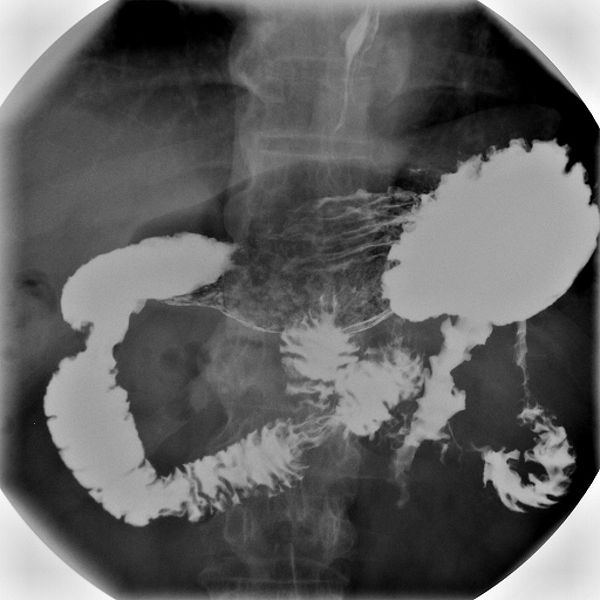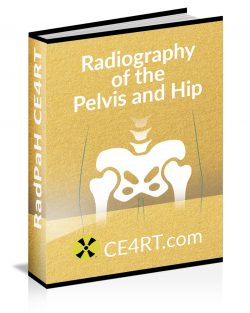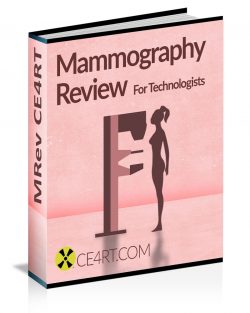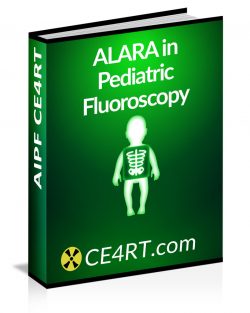Description
Get 5 Fluoroscopy CE Credits now. Guaranteed**.
1 Select a Course and Check Out
2 Download the e-book
3 Pass the online test and get your certificate
Are you aware of all the modern best practices for dose reduction in Fluoroscopy? Would you like to feel confident that your exams are being effective with a dose that is “as low as reasonably achievable”? (ALARA) This mobile friendly continuing education course discusses radiation dose and radiation protection for patients and staff when using fluoroscopy. This course meets California requirements for Fluoroscopy and is good in all 50 states for radiation protection credits and with ARRT® for category A or A+ credits.
Course Outline

The 10 Most Common Fluoroscopic Procedures
Upper Esophagus Examination, Upper Gastrointestinal Examination, Small Intestine Examination, Barium Enema Examination, Intravenous Pyelogram Cystogram / Voiding Cystourethrogram, Hysterosalpingogram, Myelogram, Angiogram – Cardiac Catheterization, Arthrogram.
High Radiation Dose Fluoroscopic Procedures
Endovascular Aneurysm Repair, Renal Angioplasty, Iliac Angioplasty, Kidney Stent Placement, Therapeutic ERCP, Venous Access Procedures, Orthopedic Procedures.
MEASURING RADIATION
Monitoring Radiation and Exposure, Radioactive Decay Exposure, Absorbed Dose, Equivalent Dose, Effective Dose, Committed Dose, Fluoroscopy Time, Total Air Kerma, Dose Area Product, Peak Skin Dose, Technological Advances in Dose Monitoring, Patient Dose Monitoring.
Biological Effects of Radiation
Deterministic Effects, Skin Injury from Fluoroscopy, Cataracts, Sterility, Acute Radiation Syndrome, Teratogenesis, Stochastic Effects, Carcinogenesis, Familial Effects, Radiation Protection for Patients, Pause and Pulse Technique, Shielding Patients, Stepping Lightly.
FLUOROSCOPY DOSE CONTROL
Necessity of Real-Time Dose Tracking, Fundamental Areas of System Performance, Advantages of Real-Time Monitoring, Fluoroscopy Equipment and Dose Management, Radiation Dose and Patient-Specific Attributes, Parameters for Dose Management
Protection of Staff in Fluoroscopy
Regulatory Limits for Occupational Exposure, Pregnant Radiographers and Radiation Workers, Staff Dose as a Relationship to Patient Dose, Staff Dose and Room Positions, Shielding for Staff Operator and Personnel, Shielding Devices Procedures and Staff Exposure, Views and Staff Exposure, Staff Training, Staff Exposure Reporting, Personal Monitoring Devices, Facility and Device Safety Requirements, Quality Assurance and Quality Control.
ARRT®* STRUCTURED EDUCATION CREDIT DISTRIBUTION FOR THIS COURSE.
What is this?
| DISCIPLINE |
CATEGORY & SUBCATEGORIES |
CE CREDITS PROVIDED |
|
|
|
| RA |
Safety – Radiation Protection and Equipment Operation |
5.00 |
|
|
|
| RA |
Safety – Patient Safety, Radiation Protection, and Equipment Operation |
5.00 |
|
|
|
| RAD |
Safety – Radiation Physics and Radiobiology |
1.00 |
|
Safety – Radiation Protection |
4.00 |
|
|
|
| CI |
Image Production – Image Acquisition and Equipment |
5.00 |
|
|
|
| VI |
Image Production – Image Acquisition and Equipment |
5.00 |
|
|
|
Understanding This Chart
This chart shows the credit distribution the ARRT®* has assigned to this activity. For R.T.s who are meeting their structured education requirements (ie. while pursuing a credential using the postprimary pathway) or as part of the continuing qualification requirements (CQR) process.
The code on the left shown in the DISCIPLINE column represents the ARRT®* content outline for the disciplines.
This chart may not show the total number of approved category A CE credits. The total number of CE Credits is in the headline at the top of this page.
What is the CQR process?
ARRT®*

The American Registry of Radiologic Technologists® (ARRT®*) accepts our courses for CE Credits.
TMB

The Texas Medical Board (
TMB) accepts our courses for Medical Radiologic Technologist Continuing Education.
FL DOH

The Florida Department of Health Bureau of Radiation Control (FLBRC) accepts our courses for Full and Limited RT CE.
CA DPH

The California Department of Public Health Radiologic Health Branch (
CARHB) accepts our courses for Radiologic Technologist CE.
ARDMS

The American Registry for Diagnostic Medical Sonography (ARDMS) accepts our courses for Ultrasound CME.
NMTCB

The Nuclear Medicine Technology Certification Board (NMTCB) accepts our courses for Nuclear Medicine CE Credits.
SDMS

The Society of Diagnostic Medical Sonography (SDMS) accepts this course for Ultrasound CME.
CAMRT

Our courses are recognized by Canadian provinces for Continuing Professional Development Credits / hours.
This 5 Credit CE course includes;
- The ability to Start Right Now, if you want you can finish and get your credits today
- Unlimited time to take the exam. You don’t have to finish today if you don’t want to.
- Work is saved as you answer each question online.
- The ability to log off and continue the online test whenever you like even from different devices.
- ASRT approved ARRT®* Category A Continuing Education Credits.
- No Faxing, No emailing back and forth, no paper.
- 100% paperless e course and reading material in the form of a pdf file e-book (not a paperback or hardcover book) that is;
- smartphone friendly
- pc friendly
- accessible
- searchable
- printable
- A Certificate of completion immediately downloadable after passing the test.
- The freedom to use different devices at different times during the same exam attempt.
- Phone, text, forum, and email support.
All available courses are approved by the ASRT for ARRT®* and every state’s Limited License Radiographer Continuing Education Credit.
How long will it take?
This is not a paperback or hardcover book. Nothing will come in the mail. This means you can start right now. Our courses follow ARRT®* Rules and are approved for the number of credits based on the amount of time it takes the reviewing body (ASRT) to read the entire reading material word for word and cover to cover. This time does not include taking the required post test. These requirements are followed for all reading material for all CE providers.
1 Credit = 1 Continuing Education Unit (CEU) = 1 Education Hour = 1 Credit Hour = 1 Hour of Reading
Many students are able to skim the material faster and search for the post test questions much more quickly than that, but the number of credits is a guideline for how many hours it will take to complete the course.
How many questions are in the test?
In order to get credit, the post test must follow ARRT®* CE rules. The rules were updated in 2016, and again in 2021. There are 8 questions for each 1 credit. So, a 1 credit course has 8 questions, a 4 credit course has 24 questions, and a 24 credit course has 192 questions. It may seem like a lot, but unfortunately it’s not our choice, this is the standard which all accredited CE providers must follow.
Our Guarantee.
** WE GUARANTEE YOU WILL GET …
– Credits that are accepted by any Radiologic Technologist, Nuclear Medicine, or Ultrasound registry in North America or US territories.
– A system that works with your smartphone and pc.
– Fast customer support if you need it.
– Electronic reading material that you can keep and share.
– An online post test that you can take from multiple devices.
– A printable hard copy of the post test for offline reference.
– A certificate of completion you can download immediately after passing the post test.
– A full refund within 30 days if you do not pass or are not satisfied for any reason.
– The lowest price with our Low Price Guarantee.
No other X-Ray CE provider offers you a guarantee like this. Try us today with no risk.
Accepted Everywhere, Guaranteed
All available courses are approved by the ASRT for ARRT® Category A CE Credit. The ARRT® accepts this approval. ALL US state agencies also accept this as approval for full and limited permit CE requirements. Most other registries in north america also accept this approval for RT and Ultrasound CE credits. Some states require specific subjects so check with your state agency.
This activity may be available in multiple formats or sold in different formats such as Google Play or Amazon. ARRT® regulations state “Lecture presentations, directed readings, home study courses, or Internet activities reported in a biennium may not be repeated for credit in the same biennium (effective January 1, 2016).”







